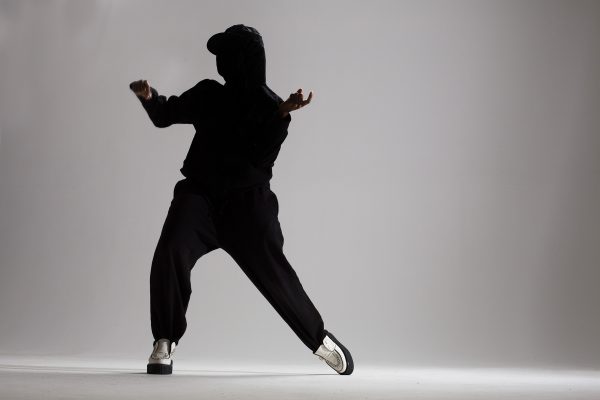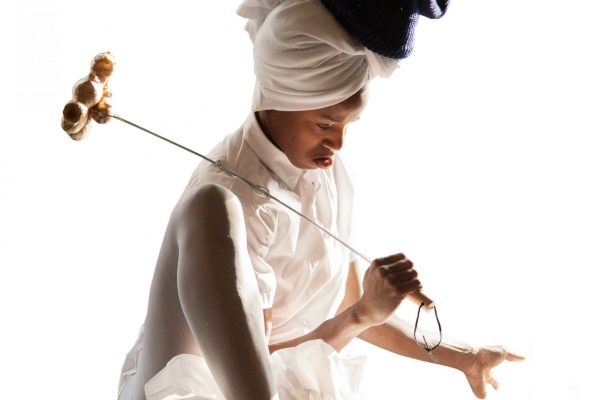When Stravinsky’s The Rite of Spring premiered in Paris on May 29, 1913, the performance famously inspired a riot. The dance community will also remember that Stravinsky’s astonishing composition was accompanied by a ballet — equally remarkable and just as controversial –choreographed by Nijinsky. “The dancers trembled, shook, shivered, stamped; jumped crudely and ferociously, circled the stage in wild khorovods,” writes the ballet historian Lynn Garafola.
Rite of Spring makes an appearance in Louise Bédard’s new work La Démarquise, which premiered at Agora de la Danse in Montréal on March 16. It’s a small reference, delivered with a wink about a quarter of the way through the 110-minute performance. The five dancers –Miriah Brennan, Marie Claire Forté, Alanna Kraaijeveld, Sarah Williams and Gabrielle Surprenant-Lacasse — stand clustered together on a box very close to the audience. One by one they start humming the opening bars of the first movement while running out onto the stage.
It’s one of a handful of references to canonical works of art woven into this show. In another sequence, the performers add gauzy strips of red material to their costumes (a miscellaneous array of outfits taken from a pile of clothes at the back of the stage). They turn and confront the audience with glaring looks and defiant gestures, while the show’s composer, Diane Labrosse, reads a description of Les Demoiselles d’Avignon, Picasso’s cruel portrait of five prostitutes. Bédard’s interpreters sarcastically reflect the painter’s Othering gaze, which is so full of fascinated horror and contemptuous familiarity. “Picasso’s monsters? That’s us,” they seem to say. “That’s all of us.”
La Démarquise bristles with provocation and rebellion against the way that society constructs femininity. The title is a play on words that inverts the honorific marquise, or noblewoman. Thus, La Démarquise is the ignoble woman. In the writing that surrounds the show, Bédard also describes La Démarquise more broadly as “the acknowledgment given to the feminine condition.” And so, in a way that is meant to be both funny and upsetting, the performance explores the idea that every woman is an ignoble woman.
Bédard’s presentation of femininity as a disturbing force follows two main themes: the whore and the geriatric. The choreographer pulls these strands — the fallen woman, the aging woman — as way of unravelling the patterns of femininity produced by society so that they ultimately disappear into a tangle of intertwined and overlapping identities. From Bédard’s writing: “La Démarquise is Louise, it’s me, her, us, and you …”
The show opens with three performers bundled into voluminous white costumes, unrolling a carpet in front of them as they enter through a brightly illuminated hallway from stage left. They wear wigs, stilettos and transparent masks with smiles pasted on — featureless, indistinguishable beauties, each a flawless blank canvas ready to receive her appointed perfection, and yet grotesquely distorted by the gleaming plastic. One by one they climb onto a wooden ramp and take turns sliding down toward the audience, a prim offering that progressively evolves into abandon. Finally, they throw themselves down onto white clouds at the back of the stage and rip off their outfits in a fit of exasperation. This concludes the preamble; the real show is everything that happens after the masks come off.
Were it not for the music, the sequence would make an effective entrance to the space that Bédard wants to explore; however, the scene is accompanied by the sound of a woman singing in Arabic, in a traditional Middle Eastern style. You don’t have to be in Québec — a province that has aggressively sought to legislate freedom for Muslim women from their cultural attire — to experience the symbolism as heavily politicized, though not in a way that is the least bit interesting or productive. To make the statement even more blunt, as the dancers begin to loosen their gestures and shake off their propriety, the Arabic music is progressively mixed with and overtaken by jazz.
Which brings us back to Rite of Spring, a work of art whose primary aim was to synthesize primitivism with the avant-garde. Just as Stravinsky stitched his composition together from elements of traditional folk songs, Nijinsky’s dancers were costumed in impressionistic versions of indigenous clothing and their movements mimicked ceremonial dancing. The composer and the choreographer were each trying to imagine their way into “pagan” Russia and thereby appropriate some ancient power for their art.
I don’t know why Bédard’s dancers hum Rite of Spring, but it seems that the choreographer shares a similar ambition as Stravinsky and Nijinsky to stake out the universal by accessing and representing primal authenticity, even if the reference is ironic. Bédard claims the feminine condition for her show, but in particular its wildness, which is vitally expressed in the figure of the prostitute. This is what she writes in the show notes, anyway: “La Démarquise is an homage to the feverish and vulnerable Demoiselles who sell their bodies and their charms.” But are prostitutes so serviceable that they can also be abstracted by anyone who wants to prove a point in a dance work? Has Bédard bested Picasso on this point or simply imitated him?
In the same breath that she charters prostitution for her creative exercise in unveiling the feminine, Bédard also adds — entre autres (among other things) in the handbill — missing and murdered indigenous women. The corresponding moment in La Démarquise involves a short soundtrack of ceremonial drumming while a lone dancer sits reflectively on the floor, which as a scene is about the choreographic equivalent of checking this terrifying national phenomenon off a list. Bédard’s indigenous fantasy isn’t nearly as lurid as Nijinsky’s, and so it is probably less presumptuous, though it’s hard to do the math on that.
These are scattered moments in a very long show, with many chapters, many props, many references and many ideas. No doubt others would tell a different story, using different elements of the performance. The clearest recurring theme is the mutability of the female dancers, as expressed by how they continually change their outfits from the large pile of clothes at the back of the stage. Each new costume activates a new mood and becomes part of a fresh anecdote. Cumulatively, all these myriad transformations make a kaleidoscope effect. This seems to be the most urgent message of La Démarquise, that the condition féminine is prismatic.
At least half a dozen people walked out of the performance I attended, but I couldn’t look away. La Démarquise is visually arresting throughout and full of sharp humour, such as when a unicorn slices a red gash in a blank canvas. Tonally, it feels like the mood at the end of a long road trip: dangerously weird, full of inspiration and unexpected intimacy, verging on out-of-control. In the final sequence, for example, the five dancers line up across the stage to perform a sustained explosion of jittery, full-bodied movements while wearing purses on their heads. But this wild ride of ideas leaves too many casualties of thoughtlessness. Bédard aims for the universal, and she uses anything in her path to get there.
Tagged: Choreography, Contemporary, Performance, Montréal , QC




